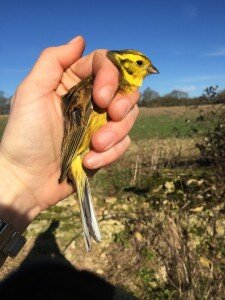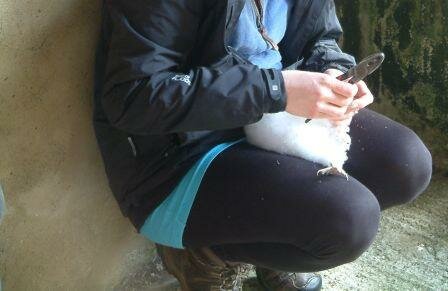
I completed my last ringing session of the winter in April. Despite the excessively wet and windy conditions over the winter period, I managed six mist-netting sessions at Woeful Lake Farm and a further session at Stones Farm. The site at Woeful Lake Farm consists of arable fields with a large area of cover crop and mature hedgerows. The site at Stones Farm is an old quarry surrounded by arable fields with grassy field margins and mature hedgerows. The quarry has a sheltered grassy area surrounded by scrubby bushes and trees. Both sites have been fed with seed throughout the winter. The site at Stones Farm has very good numbers of Yellowhammer, Linnet and Reed Bunting and looks to be a promising addition to the project next winter.
The table below summarises the birds caught for the first time and those recaptured throughout the winter period.
| Species |
New birds |
Recaptures |
| Wren |
1 |
|
| Great Spotted Woodpecker |
1 |
|
| Dunnock |
15 |
3 |
| Robin |
5 |
2 |
| Blackbird |
3 |
|
| Goldcrest |
3 |
|
| Long-tailed Tit |
2 |
|
| Coal Tit |
1 |
|
| Blue Tit |
48 |
21 |
| Great Tit |
14 |
1 |
| Chaffinch |
17 |
|
| Greenfinch |
12 |
1 |
| Goldfinch |
2 |
|
| Linnet |
13 |
|
| Yellowhammer |
8 |
|
| Reed Bunting |
1 |
|
The numbers of Linnet and Yellowhammer caught increased towards the end of the winter. This is because natural food supplies diminish as winter progresses and birds gather at areas where food remains – in this case where we provided supplementary seed. The relatively warm winter this year may have reduced the size of winter flocks – although there was a flock of up to 80 Linnet using the site this year, this is considerably smaller than the flock of several hundred present in previous years.
Examination in the hand revealed that the Yellowhammers and Linnets caught were a relatively even mixture of adult birds and first year birds (i.e. birds born in the 2015 breeding season). Previous studies and ringing recoveries have shown Yellowhammers in particular to be sedentary, with similar breeding and winter distributions and few long distances movements of birds. The capture of first year birds therefore indicates that Yellowhammers have bred successfully in the area last year and in the future it should be possible to look at changes in the proportion of adults to first year birds as an indicator of changes in breeding success.
To date I have only had one recovery of a ringed bird by a third party. A Great Tit ringed in December was recaptured by another bird ringer in Sibford Ferris (Oxfordshire) on 31 March 2016, a movement of 31km. It is unusual for a Great Tit to move as far as this but first year birds, such as this one, are known to be more likely to disperse than adults.
A more detailed report of the project so far can be found in the NCOS newsletter, and please continue to look out for colour ringed Corn Bunting (yellow with black characters) and Yellowhammer (dark blue with white characters) on the Sherborne Park Estate.


















